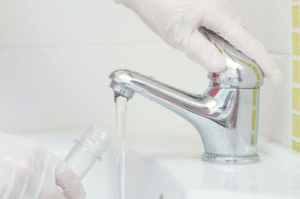What To Look For During Residential Water Testing?
Water is an essential resource used daily in our homes for cooking, bathing, consumption, and various other purposes. Routine professional residential water testing is important to ensure that water quality is safe for use and consumption.
Contaminated water is not always easy to identify and can lead to serious illnesses. The following informational guide reveals signs of water contamination and how professional water tests are performed.
What Does Professional Residential Water Testing Include?

Residential water testing requires a professional to obtain a water sample, test, identify and evaluate levels of specific minerals or chemicals presence within the sample.
Professional Water Testing Checks For:
- Sodium
- PH
- Fluoride
- Iron
- Magnesium
- Nitrites
- Hardness
The residential water testing professional will then provide a detailed analysis of their finding for homeowners to evaluate. These results will reveal whether a water softener or a new filtration system needs to be implemented to improve water quality.
Professional water testing also checks for dangerous bacteria, viruses, and pesticides that have the potential to lead to numerous diseases and illnesses.
Types of Residential Water Testing
There are three main water quality parameters that professionals use to evaluate the quality of a home water supply.
Water Quality Parameters Include:
- Physical Parameters- Color, Taste, Odor, Etc.
- Chemical Parameters- PH, Acidity, Chlorine, Hardness
- Biological Parameters- Bacteria, Viruses, Algae
All of these properties are essential for determining whether or not a water supply is safe for use and consumption.
Why Should You Test Your Water Professionally?

Water contamination can occur for numerous reasons, including inadequate plumbing fixtures, poor water treatment facilities, or other causes. There are several circumstances in which it may be a wise decision to have a professional test your water supply.
Cloudy Water
Water that appears cloudy or tinted should be tested to determine if water softeners are needed.
Unpleasant Taste or Smell
Unpleasant or odd-tasting water is a clear indication that your water supply needs to be tested for numerous elements, compounds, and bacteria.
Old Plumbing Fixtures
Older homes were often constructed using lead pipes. This can lead to dangerous amounts of lead deposited into the home drinking water supply. Any home built during the 20th century may have lead components and should have its water supply tested.
Rural Areas
You should have your water tested more frequently if you reside in a rural area. Water supplies for homes in rural locations are notoriously exposed to contamination from nearby agriculture compounds, including pesticides and nitrates.
After Natural Disasters
Storms that bring heavy rain can lead to flooding that has the potential to contaminate nearby water. Water should be tested after any water-related natural disaster occurs that may have affected the water supply.
Things to Pay Attention To In Your Water Quality Report

Water quality reports reveal crucial information about the safety of your home water supply. These reports contain various parameters and units of measure that can be confusing and difficult for many homeowners to interpret. There are several areas of this report that you should pay special attention to for a better understanding of the water quality.
The report will reveal extensive data on each substance tested for in the professional water lab test that was performed. The report will also reveal the amount discovered in unique measurements based on the criticality of each substance.
Metals and nitrates are measured in milligrams per liter (mg/l) or part per million (ppm).
Pesticides and other dangerous substances are measured in smaller units, parts per billion (ppb), because of their highly hazardous nature.
Other units listed on the water quality report may be less familiar and specific to each test. For example, levels of pH, hardness, and turbidity use specific measurement terms.
Your report will also contain a notes section. This is an important section to pay attention to because it will reveal any unsafe levels of substances discovered as a result of the testing. The lab will make a note of any containment levels that exceeded safe water consumption guidelines.
MD Mold Testing
Contact MD Mold Testing today to learn more about the importance of water quality testing. MD Mold Testing provides environmental testing services 7 days a week serving locations throughout Maryland, Virginia, Washington D.C., and Delaware.





